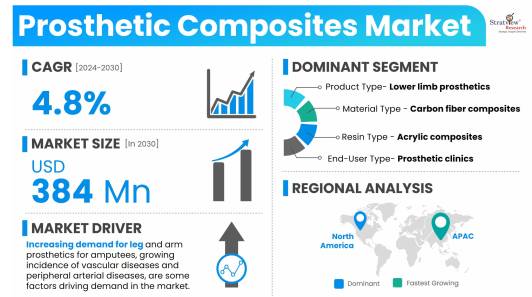Market Insights
The prosthetic composites market was estimated at USD 273 million in 2023 and is likely to grow at a CAGR of 4.8% during 2024-2030 to reach USD 384 million in 2030.

Want to know more about the market scope? Register Here
Market Dynamics
Introduction
Prosthetics are nothing short of a miracle for millions of people with congenital conditions, liabilities, and injuries. Prosthetics is the branch of medicine that treats the damage to the skeletal system, ligaments, and muscles. It comprises prosthetics (devices that substitute for a limb or joint) and orthotics (lower back support and knee braces). Since the first use of artificial legs, the orthopedics market has come a long way. The biggest technological leap occurred in the late 1980s with the advent of composite materials in producing orthopedic devices.
This industry highly relies on high-performing composites, as they offer the best chance to recreate the diverse structures of our bones and limbs so that prosthetics can perform just as well as the real deal. Prosthetic devices from composite materials deliver excellent lightweight, durable, and corrosion-resistant features. Owing to these advantages, composite materials started gaining traction in sporting events such as the Paralympic and Olympics. However, the high cost of these materials is still acting as a bottleneck towards greater adoption among the user base.
Recent Developments
Other than a large number of M&A activities and product development, the market has consistently moved forward over the past few years.
- Fillauer partnered with Protolabs Network: Fillauer Composites manufactures prosthetic feet using carbon fiber and fiberglass. Fillauer partnered with Protolabs Network to reduce the cost of production and open up more time for their engineers to focus on perfecting the designs.
- Cevotec’s Patch2Patient Project: The base technologies for establishing a digital, flexible, and automated value chain to produce personalized composite medical products, such as prosthetics and orthotics, have been developed in the Patch2Patient project coordinated by Cevotec in Germany.
- Allard's new Dynamic Response Foot - Meracus®: Meracus® sets a new standard in prosthetic design, crafted from 100% composite materials. It is a prosthetic foot free from metal joints and extraneous components. The pure composite design, combined with a rocker sole, ensures a smooth, natural transition from heel strike to toe-off.
Segment Analysis
|
Segmentations
|
List of Sub-Segments
|
Segments with High Growth Opportunity
|
|
Product-Type Analysis
|
Orthotics, Lower Limb Prosthetics, and Others
|
Lower limb prosthetics are expected to be the prime demand generator for composites in prosthetic applications.
|
|
Material-Type Analysis
|
Nylon Composites, Cotton Composites, Carbon Fiber Composites, and Others
|
Carbon fiber composites are likely to take the market by storm in the future with lucrative opportunities for market stakeholders.
|
|
Resin-Type Analysis
|
Acrylic Composites, Vinyl Ester Composites, Epoxy Composites, and Other Composites
|
Acrylic composites were the most preferred material for prosthetics. However, epoxy composites remain the epicenter for hustle-bustle in the market.
|
|
Process-Type Analysis
|
Wet Lamination, Prepreg Layup, and Others
|
Wet lamination took the lead in the market, proving to be the most sought-after process type; prepreg layup is likely to grow at the highest rate.
|
|
Technology-Type Analysis
|
Technical Composites and Advanced Composites
|
Technical composites remained at the forefront with a higher share in 2023.
|
|
End-User Type-Analysis
|
Hospitals, Prosthetic Clinics, and Ambulatory Surgical Centers
|
Prosthetic clinics grabbed a major chunk of the market and are expected to remain dominant by 2030.
|
|
Regional Analysis
|
North America, Europe, Asia-Pacific, and Rest of the World
|
North America is expected to maintain its reign over the forecast period, whereas Asia-Pacific is likely to expand at the fastest rate.
|
By Product Type
“Lower limb prosthetics are expected to remain the dominant demand-generating application in the market by 2030”.
- The market is segmented into orthotics, lower limb prosthetics, and others.
- Key factors propelling growth: High cases of lower limb amputations, improving healthcare spending across the globe, and higher adoption of composite materials in artificial leg manufacturing.
- According to the World Health Organization and other groups monitoring amputation and limb loss, 60 to 100 million people worldwide need a prosthetic limb. This population is expected to double by 2050, driven primarily by the growth in diabetes and vascular disease. Depending on the country and age group, >80% of those needing prostheses involve lower limbs, yet only 5% to 15% of amputees have access to prosthetics.
By Material Type
“Carbon fiber composites are anticipated to remain the fastest-growing fiber type in the market during the forecast period”.
- The market is segmented into nylon composites, cotton composites, carbon fiber composites, and others.
- There has been an incessant increase in the adoption of carbon fiber composites in lower limb prosthetics in the wake of greater performance including excellent strength-to-weight ratio and corrosion resistance over their counterparts.
- Carbon fiber is used widely across the industry because it is malleable enough to create the unique, tailor-made, and complex structures needed for high-performance prosthetics.
- Carbon fiber composites are also ideal for producing parts with compound curves and thin walls. Even the most complex prosthetics are made possible with carbon fiber.
By Resin Type
“Epoxy composites are expected to mark exceptional growth in the market during the forecast period”.
- The market is segmented into acrylic composites, vinyl ester composites, epoxy composites, and others.
- Epoxy is highly compatible with carbon fiber, which is rapidly being adopted for composites in prosthetic applications.
- High specific strength: Carbon/epoxy composite most closely resembles native bone in absolute strength, modulus, and fracture toughness.
- Ideal weight distribution: The specific strength of the carbon/epoxy composite is so high that it is possible to produce a prosthesis that has the same strength as a natural leg, but at the same time is up to 60% lighter.
- Hygiene: After curing and washing, epoxy resin does not irritate the human skin and is non-allergic. Accidental exposure of the skin to the prosthesis does not cause any harm.
Regional Analysis
“North America is expected to remain the largest market for prosthetic composites during 2024-2030”.
- North America has well-formulated healthcare policies regarding prosthetics & orthotics, huge healthcare expenditure, and higher adoption of advanced technology.
- In terms of countries, the USA is expected to remain the largest market, globally.
- According to ‘Amputee Coalition Org.’, more than 5.6 million people are currently living with limb loss (2.3 million people) or limb difference (3.4 million people) in the USA. Lower limb amputations occur more frequently (~83%) as compared to upper limb amputations (~17%).

Know the high-growth countries in this report. Click Here
Key Players
The market is highly consolidated, with the presence of a handful number of players globally. Most of the major players compete in some of the governing factors including price, service offerings, regional presence, etc. The following are the key players in the Prosthetic Composites Market:
Note: The above list does not necessarily include all the top players in the market.
Are you the leading player in this market? We would love to include your name. Write to us at [email protected]
Report Features
This report provides market intelligence in the most comprehensive way. The report structure has been kept such that it offers maximum business value. It provides critical insights into market dynamics and will enable strategic decision-making for existing market players as well as those willing to enter the market. The following are the key features of the report:
- Market structure: Overview, industry life cycle analysis, supply chain analysis.
- Market environment analysis: Growth drivers and constraints, Porter’s five forces analysis, SWOT analysis.
- Market trend and forecast analysis.
- Market segment trend and forecast.
- Competitive landscape and dynamics: Market share, Service portfolio, New Product Launches, etc.
- COVID-19 impact and its recovery curve
- Attractive market segments and associated growth opportunities.
- Emerging trends.
- Strategic growth opportunities for the existing and new players.
- Key success factors.
Market Segmentation
This report studies the market, covering 12 years of trend and forecast. The report provides detailed insights into the market dynamics to enable informed business decision-making and growth strategy formulation based on the opportunities present in the market.
The prosthetic composites market is segmented into the following categories:
By Product Type
- Orthotics
- Lower Limb Prosthetics
- Others
By Material Type
- Nylon Composites
- Cotton Composites
- Carbon Fiber Composites
- Others
By Resin Type
- Acrylic Composites
- Vinyl Ester Composites
- Epoxy Composites
- Other Composites
By Process Type
- Wet Lamination
- Prepreg Layup
- Others
By Technology Type
- Technical Composites
- Advanced Composites
By End-User Type
- Hospital
- Prosthetic Clinics
- Ambulatory Surgical Centers
By Region
- North America (Country Analysis: The USA, Canada, and Mexico)
- Europe (Country Analysis: Germany, France, The UK, Russia, and the Rest of Europe)
- Asia-Pacific (Country Analysis: China, India, Australia, South Korea, and the Rest of Asia-Pacific)
- Rest of the World (Country Analysis: Saudi Arabia, Brazil, and Others)
Research Methodology
- This strategic assessment report from Stratview Research provides a comprehensive analysis that reflects today’s orthopedic composites market realities and future market possibilities for the forecast period.
- The report segments and analyzes the market in the most detailed manner in order to provide a panoramic view of the market.
- The vital data/information provided in the report can play a crucial role for market participants as well as investors in the identification of the low-hanging fruits available in the market as well as to formulate growth strategies to expedite their growth process.
- This report offers high-quality insights and is the outcome of a detailed research methodology comprising extensive secondary research, rigorous primary interviews with industry stakeholders, and validation and triangulation with Stratview Research’s internal database and statistical tools.
- More than 1,000 authenticated secondary sources, such as company annual reports, fact books, press releases, journals, investor presentations, white papers, patents, and articles, have been leveraged to gather the data.
- We conducted more than 15 detailed primary interviews with market players across the value chain in all four regions and industry experts to obtain both qualitative and quantitative insights.
Customization Options
With this detailed report, Stratview Research offers one of the following free customization options to our respectable clients:
Company Profiling
- Detailed profiling of additional market players (up to three players)
- SWOT analysis of key players (up to three players)
Competitive Benchmarking
- Benchmarking of key players on the following parameters: Service portfolio, geographical reach, regional presence, and strategic alliances
Custom Research: Stratview Research offers custom research services across sectors. In case of any custom research requirement related to market assessment, competitive benchmarking, sourcing and procurement, target screening, and others, please send your inquiry to [email protected]

